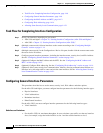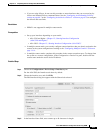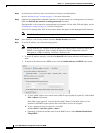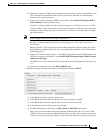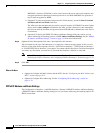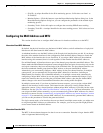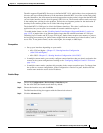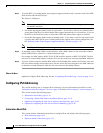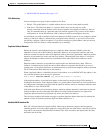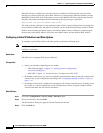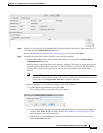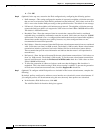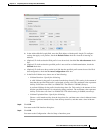
14-12
Cisco ASA 5500 Series Configuration Guide using ASDM
Chapter 14 Completing Interface Configuration (Routed Mode)
Completing Interface Configuration in Routed Mode
–
SLA ID—A unique identifier for the SLA monitoring process. Valid values are from 1 to
2147483647.
–
Monitor Options—Click this button to open the Route Monitoring Options dialog box. In the
Route Monitoring Options dialog box you can configure the parameters of the tracked object
monitoring process.
–
Secondary Track—Select this option to configure the secondary PPPoE route tracking.
–
Secondary Track ID—A unique identifier for the route tracking process. Valid values are from
1 to 500.
Configuring the MAC Address and MTU
This section describes how to configure MAC addresses for interfaces and how to set the MTU.
Information About MAC Addresses
By default, the physical interface uses the burned-in MAC address, and all subinterfaces of a physical
interface use the same burned-in MAC address.
A redundant interface uses the MAC address of the first physical interface that you add. If you change
the order of the member interfaces in the configuration, then the MAC address changes to match the
MAC address of the interface that is now listed first. If you assign a MAC address to the redundant
interface using this command, then it is used regardless of the member interface MAC addresses.
For an EtherChannel, all interfaces that are part of the channel group share the same MAC address. This
feature makes the EtherChannel transparent to network applications and users, because they only see the
one logical connection; they have no knowledge of the individual links. The port-channel interface uses
the lowest numbered channel group interface MAC address as the port-channel MAC address.
Alternatively you can manually configure a MAC address for the port-channel interface. In multiple
context mode, you can automatically assign unique MAC addresses to interfaces, including an
EtherChannel port interface. We recommend manually, or in multiple context mode, automatically
configuring a unique MAC address in case the group channel interface membership changes. If you
remove the interface that was providing the port-channel MAC address, then the port-channel MAC
address changes to the next lowest numbered interface, thus causing traffic disruption.
In multiple context mode, if you share an interface between contexts, you can assign a unique MAC
address to the interface in each context. This feature lets the ASA easily classify packets into the
appropriate context. Using a shared interface without unique MAC addresses is possible, but has some
limitations. See the “How the ASA Classifies Packets” section on page 11-3 for more information. You
can assign each MAC address manually, or you can automatically generate MAC addresses for shared
interfaces in contexts. See the “Automatically Assigning MAC Addresses to Context Interfaces” section
on page 11-20 to automatically generate MAC addresses. If you automatically generate MAC addresses,
you can use this procedure to override the generated address.
For single context mode, or for interfaces that are not shared in multiple context mode, you might want
to assign unique MAC addresses to subinterfaces. For example, your service provider might perform
access control based on the MAC address.
Information About the MTU
The MTU is the maximum datagram size that is sent on a connection. Data that is larger than the MTU
value is fragmented before being sent.





